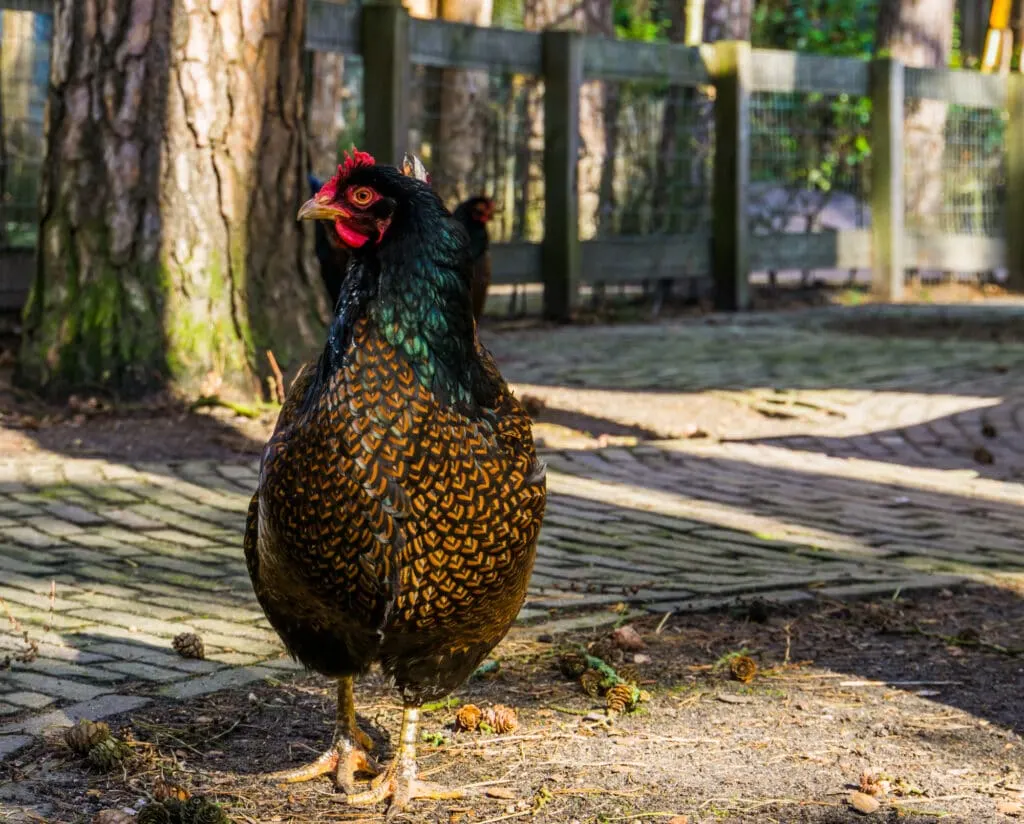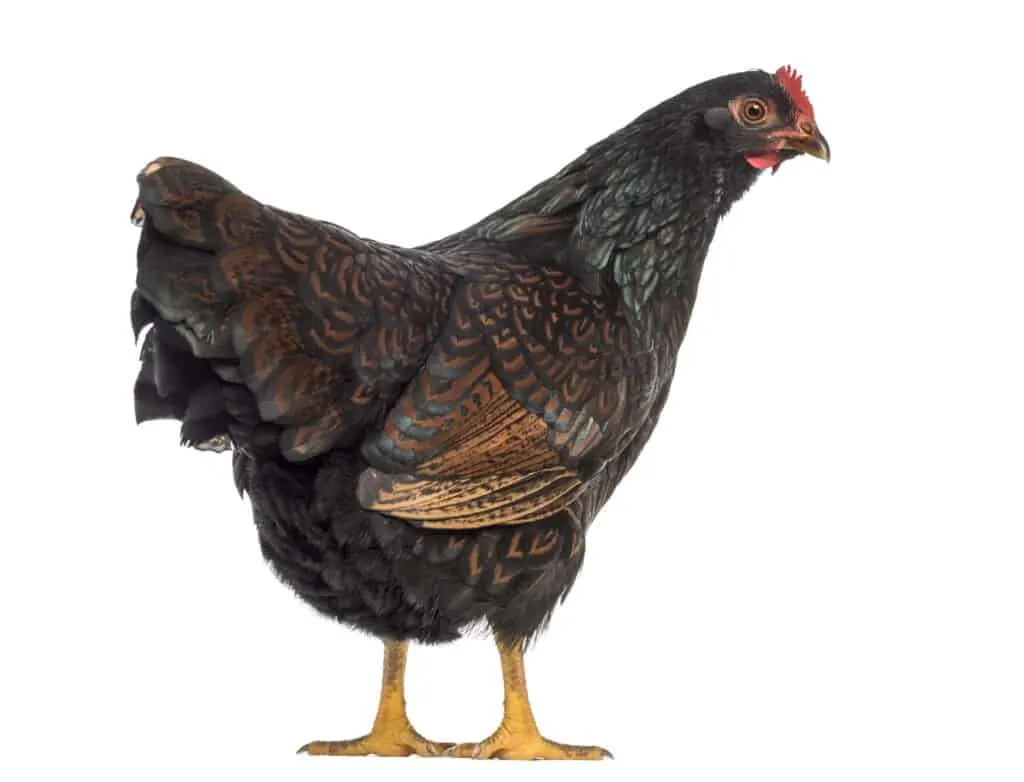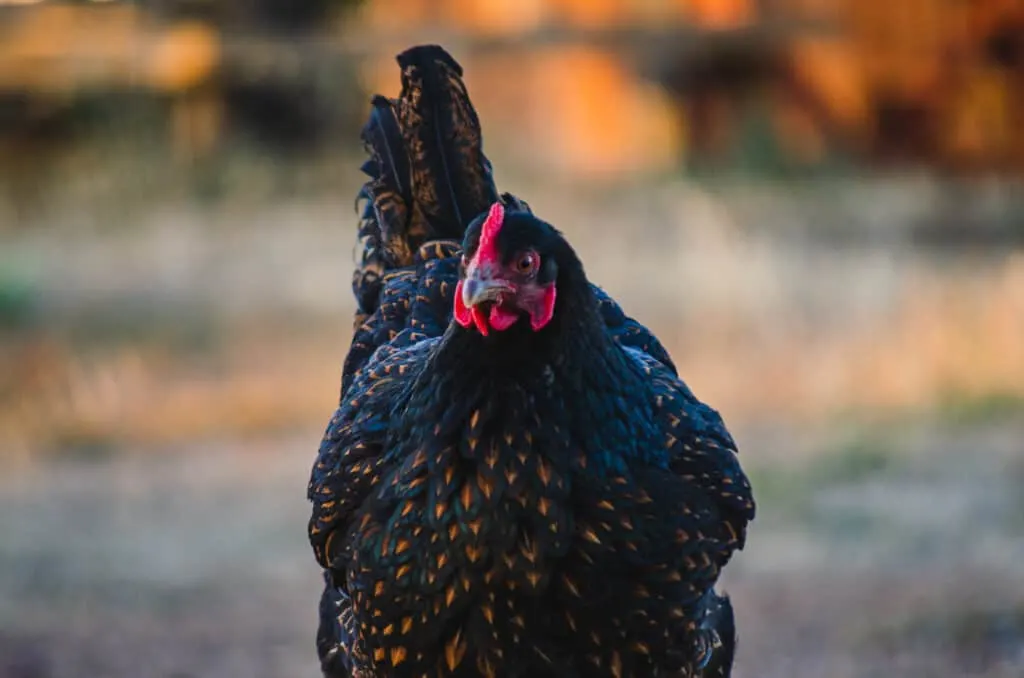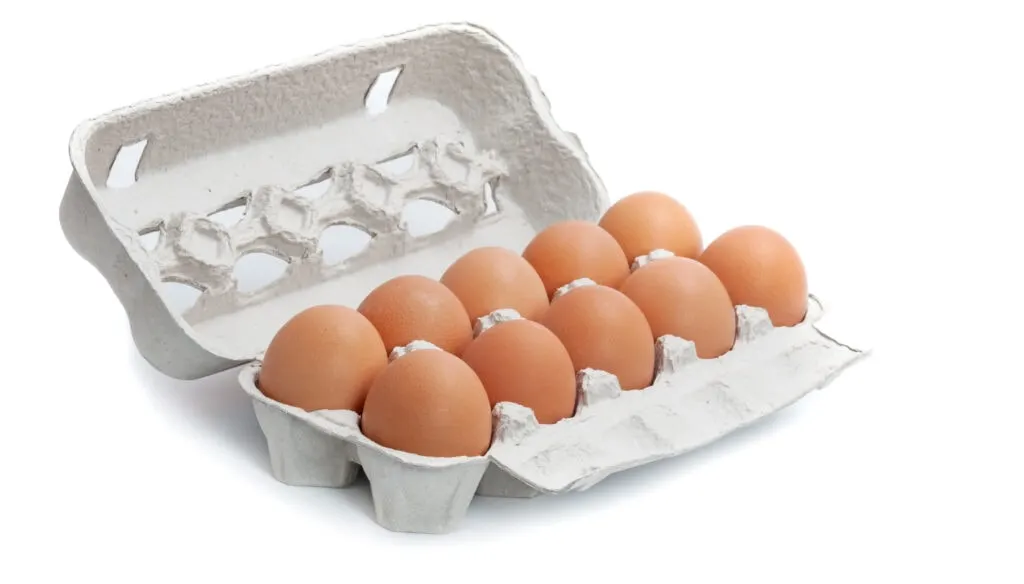Disclaimer: This website contains affiliate links, from which Heritage Acres Market LLC may receive a small commission from the vendor on the sales of certain items, all at no cost to you. Please read our full disclosure for more information. Thank you for supporting Heritage Acres Market LLC!
The Barnevelder chicken is a dual-purpose, winter egg-laying breed originating from the Netherlands. It features hens with beautiful double-laced feather patterns that lay brown eggs and have a friendly nature.
Is the Barnevelder chicken right for your flock?
- Good layer of brown eggs, even through the winter
- Attractive double laced feather pattern
- A hardy bird that does well in a variety of climates
- Great for both children and beginners
Table of Contents
Background and History of the Barnevelder Chicken Breed
The Barnevelder chicken breed originated in Barneveld, a small town in the Netherlands, South East of Amsterdam. Barneveld is regarded as the cradle of Dutch poultry farming and is even home to the Dutch Poultry Museum.
Barnevelders are a large fowl that has been around since the 12th or 13th century and were initially used as utility birds by the local farmers. They were a mishmash of different shapes and colors with no distinctive characteristics. It wasn’t until late in 1921 that the breed standard was developed, when over 100,000 birds from the local district were inspected, and just 2,000 passed as suitable for breeding. It was these birds that were used to establish today’s Barnevelder breed.

Barnevelder chickens were created by crossing the common fowl of the Barneveld area with Asian breeds, Cochins, Brahmas, and Langshans that arrived in Holland during the 19th century. It was this Asian influence that caused the brown-colored eggs Barnevelders now lay.
Buff fowl of Asiatic derivation commonly throw penciled or laced feathers when crossed, and this is most probably the origin of the first laced birds in the Barnevelder breed. The Buff Orpington was also used to standardize the breed.
Double Lacing
The first Barnevelder chickens didn’t exhibit the double laced feather pattern so iconic of today’s hens. They mostly had brown speckled feathers with a light shaft and a single, broad, black outer lacing.
The double lace feathering happened by accident in 1922 with a bird owned by a breeder called W. Middelman. Exactly how that double lacing was achieved is debated. Many say it was done by crossing the single-laced hens with Indian Game birds, but the Dutch breeders refute it. The bantam Barnevelder, however, does have an Indian Game influence.
Much excitement surrounded the double-laced bird, and Dutch breeders worked to produce more and more of them. In 1923, the double-laced Barnevelder was recognized by the Dutch Poultry Club.
Although the Barnevelders are not a heritage breed in America, they are in Holland. It is possible that early Barnevelders first appeared in the US in the early 1900s as they did in England, but exact importation dates are unknown.
The beauty of the double-laced Barnevelder has caused a surge in demand in recent times. They remain an uncommon chicken breed in the US but are not considered under threat.

Temperament and Behavior
The Barnevelder is a calm, friendly, yet active hen who is easy to care for and gets on well with other flock mates. Her easy-going nature and willingness to be tamed make her suitable as a kids bird.
The only downside is that they rarely go broody. They are ideal as a backyard hen for beginners or a show bird for an experienced chicken keeper.
Roosters are also known for their easy-going disposition, and it is recommended to keep five females to every male.
They like to free-range and enjoy the freedom of browsing in open spaces but can also tolerate being caged if necessary.
Breed Specifics
Originally Barnevelders were seen as dual-purpose egg and meat birds, but today they are more recognized as egg layers or used for display in exhibitions or poultry shows.
Considering their varied origins, the breed now has a definite standard and appearance.
The Barnevelders body is deep and broad with a concave back, running from neck to tail. The head is short and broad with reddish bay eyes and a strong, yellow beak.
Barnevelders have a single, medium size red comb and wattles. Their plumage is full and close feathered with a medium size tail that reaches no higher than the top of their head. Sickles and saddle feathers cover the primary feather of the tail.
The skin should be yellow. Barnevelders have yellow legs that are clean, and with four toes. The soles of the feet must also be yellow.
Barnevelders are medium-sized chickens. The hens reach approximately 5.5 to 6 pounds, while roosters are 6.6 to 7.7 pounds. Bantam Barnevelders weigh 1.98 to 2.2 pounds for hens and 2.2 to 2.64 pounds for roosters.
Hens usually take six months (26 weeks) on average to reach full maturity, while Roosters take 8 to 9 months (34 to 39 weeks). This breed reaches an average age of approximately eight years.

Feather Pattern and Colors
Although there is self black Barnevelder and white Barnevelder chickens, the most famous and popular are the double-laced birds. The double lacing on the hens is exquisite and features an iridescent black head and neck feathers that transition to a deep bronze with black double lacing over the breast, back, wings, and tail.
The roosters have an iridescent black breast and tail with a glossy deep red saddle, hackle, and flight feathers. The double laced Barnevelder is the only type of hen and rooster currently recognized by the American Poultry Association and was accepted into the American Standard of Perfection in 1991. In some countries, the Barnevelder rooster also has double-laced breasts like the hens.
Other colors exist around the world; most have been created in Holland, Germany, and the United Kingdom, including:
- Blue Double laced
- Blue Double laced bantam
- Blue splash
- Silver laced
- Silver black double laced
- Silver black double laced bantam
- Silver blue double laced
- Black
- Black bantam
- White
- White bantam

Barnevelder Chicks
Day-old Barnevelder chicks of the recognized variety are born with a single black stripe down their back and a pattern of black, bronze, and gray down. The chicks with a paler gray chest are usually roosters, while hens have a darker brown-gray chest. The hens also tend to feather up faster than the roosters.
The chicks are hardy and easy to care for, but they are very susceptible to Marek’s disease. Marek’s disease is caused by a herpes virus, and unvaccinated chicks often die at a very young age. The condition causes paralysis and then death. To prevent chicks from getting the ailment, they need to be vaccinated within the first 24-hours after hatching.
It takes chicks quite some time to mature, 8 to 9 months for roosters and around six months for hens.
Health Considerations
High levels of inbreeding have been used to produce and maintain the double laced feather pattern. This inbreeding is why Barnevelders have become susceptible to Marek’s disease, which affects young chicks. Other than this, there are no other particular ailments that commonly affect the breed.
All the standard precautions and preventative measures should be taken to ensure the birds remain free from parasites, including routine health checks to stop blood-sucking insects such as lice and mites.
Maintaining a clean environment with access to fresh water, a well-ventilated and insulated chicken coop, and good quality feed are generally enough to maintain your bird’s health.
Be cautious with any kitchen scraps you feed your birds and ensure what you give them is not toxic or moldy. Also, be careful not to overfeed treats.

Other Traits
The Barnevelder, coming from a part of Europe where winters can be cold and wet, is a hardy breed and will tolerate cold, damp conditions well. They also manage hot weather, provided they have a shady place to shelter and a plentiful supply of cold water.
During particularly cold conditions, their combs may freeze, causing frostbite. To help avoid this, ensure the chicken coop has adequate ventilation.
Due to their feather color and activeness, Barnevelders are reasonably good at evading predators when free-ranging during the day. All chickens should be kept safely shut away in a coop at night for protection.
Barnevelder Chicken Eggs
A Barnevelder hen can take longer than other dual-purpose breeds to start laying her eggs. Usually, she begins to lay by eight months of age, but it can take as long as ten months for some individuals.
The eggs themselves range in color from deep brown to pale brown. This is because in the early days before Barnevelders were double laced, they were raised to produce large dark brown eggs throughout the year.
During the breed’s development, their egg-laying abilities became overshadowed by the desire to reproduce the double laced feather patterns, to the detriment of their egg color, amongst other things.
Inbreeding has also affected the birds parenting abilities. Barnevelders were traditionally good mothers that would brood and raise their chicks. Today, however, a lot of this natural instinct has been bred out of them.

The number of eggs a Barnevelder pullet will lay varies from around 170 to 200 eggs per year. Some people report their hens laying more than this. Traditionally used as winter layers, some strains have also lost this useful trait. If you want to have good winter laying birds for egg production, check with the producer of your hens to ensure this trait is still intact.
As with other brown egg chickens, it isn’t unusual for the color of the eggs to begin as a dark brown egg, only to gradually become lighter as the season continues. This variation is normal and just means that the gland responsible for coloring the eggs cannot keep up with the production rate. If dark brown eggs are desired, choose the hens that lay the darkest eggs in spring when selecting birds to breed from.
Hatching Barnevelder eggs in an incubator can sometimes be problematic. Their eggs often have a very spherical shape with no real difference between the top and the bottom. Unfortunately, this affects the air sack within the egg, making it unsuitable for a Barnevelder chick to hatch from.
They also have tough egg shells, which can again cause problems with hatching when using an incubator. For some reason, this seems to be less of an issue when using a broody hen.

Where to Buy Barnevelder Chickens
Due to the rarity of Barnevelder chickens in the US, it can be a little tricky to find places that stock them. They are gaining popularity in some areas and fast becoming a favorite of backyard chicken keepers due to their beautiful feather pattern, winter laying ability, and friendly nature.
You may be able to find chicks by looking for a local breeder on PoultryFinder.com, or on the American Barnavelders Club website.
Cackle Hatchery also sells Barnevelder chicks at a very affordable price, which can be shipped to your door. Cackle Hatchery is our preferred and recommended hatchery. While most hatcheries require orders of at least 25 chicks, you can buy as few as 3 chicks from Cackle. They are also highly rated on Google and have been in business since 1936.
Summary
The Barnevelder is a rare, beautiful, and enchanting bird with a wonderful friendly nature. Due to their rarity, they are still a little challenging to find and can be more expensive than many other breeds.
If you like unusual colors and feather patterns, then having some in your flock is bound to give you pleasure every time you see them.
For Barnevelders that lay eggs during the winter months, be sure to check your strain when purchasing from your supplier.
Barnevelder Chicken Overview
| Breed Name | Barnevelder |
| Type | Exhibition/Dual Purpose heavy |
| Size | Medium |
| Heritage Breed | Not in the US |
| Average Weight | Rooster 6.6 to 7.7 lbs, Hen 5.5 to 6 lbs Bantam Rooster 2.2 to 2.6 lbs, Hen 1.9 to 2.2 lbs |
| Weeks To Maturity | Rooster 34 to 39, hen 26 |
| Average Life Span | 8 years |
| Color variations | Only one color is recognized in the US – Double laced. Other colors include – Silver laced, silver black double laced, blue double laced, silver blue double laced, black, white and blue splash |
| Egg Size | Large |
| Egg Color | Dark brown to light brown |
| Egg Production | 170 to 200 per year – good winter layers |
| Dual Purpose | Yes |
| Temperament | Friendly and active |
| Beginner Friendly | Yes |
| Kid Friendly | Yes |
| Heat Tolerant | Yes |
| Cold Tolerant | Yes |
| Comb Type | Single |
| Broodiness | Unusual |
| Flightiness | Not flighty |
| Noise Level | Medium |
| Unique Traits | Double laced feathers |
